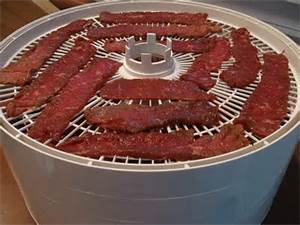Dehydrating Meats

Dehydrating meats is one of the best ways to ensure that your family has what they need to survive in the event that you would need to depend on the emergency food stock that you have stashed away over time. Dehydrated meats are easy to store and can be made from not only your typical meat sources like chicken and beef but also from more wild game such as deer and turkey.
Even if you have very little experience with dehydrating food and preparing it for long-term storage, drying meats is a simple enough process that with just a bit of practice, you too can be storing away large amounts of savory homemade food for a rainy day.
Dehydrating Meats: What You Need to Know
Drying meat for later use is done in a variety of ways; the easiest way to accomplish this feat is with an electric dehydrator. Most types of meat can be dried for later use – you just need to remember to clean it well and remove as much of the fat as possible before you begin. Most meats will take anywhere from 3-12 hours to dehydrate depending on their thickness and how they were prepared.
Easy Ideas for Dehydrating Meats
While most dehydrated meats will not have exactly the same texture when they are revived – they can still be used as a major source of protein as part of a camping meal plan or as part of your emergency food stock. Try a few of these simple ideas for getting started.
Lunch Meats
One of the simplest types of meat that you can dehydrate is lunchmeat. This is because when you purchase them from the store they are already precooked and sliced, which takes away much of the prep time and work. To dehydrate these meats simply line the trays of your dehydrator with paper towels to prevent the meat from falling through and turn on the machine.
Check on your meat periodically to check progress and to remove any pieces that may finish drying before others. As with any other dehydrated food, store in airtight or vacuum-sealed bags or canisters to keep them fresh.
Note: Choose low fat lunch meats and preferably those that don’t use nitrates.
Ground Meats
If you are dehydrating meats that are ground such as beef or turkey – here are a few things to remember. First, go ahead and brown your meat on the stove, making sure it is well done as you can get it – with no signs of redness, as this will help kill any bacteria in the meat. Once your meat is cooked, place your meat in a strainer and run it under lukewarm water to rinse away any remaining grease and fat that may be lingering.
Remember – the more fat that stays on your meat, the faster it will go rancid once it is dehydrated. As with the lunchmeat, line your trays with paper towels, freezer paper or use your dehydrator fruit leather trays, and turn on your dehydrator.
Check progress occasionally and shift around the meat if you can as this will speed up the drying process a tad. Store as you would any other dehydrated food product.
*Helpful hint: It has been discovered that mixing a small amount of breadcrumbs into your ground meat before you dehydrate will help keep it tender when you rehydrate it later on.
Shrimp
While it is less common, you can also shrimp for later use as well. If you want to dehydrate shrimp, save time, buy a bag of precooked and peeled shrimp. Before dehydrating, break off the tails and cut each shrimp into several small pieces before rinsing them at the sink. Line your tray with paper towels to avoid losing pieces as they shrink and arrange your shrimp chunks evenly across the tray. Dehydrating shrimp should take anywhere from six to eight hours depending on your dehydrator. Check progress periodically and remove any pieces that dry before the others.
An easy way to ensure that your families will have full bellies on wilderness adventures or during times of crisis, dehydrating meat and storing it for later use is quite simple once you get the hang of it. If done properly meat will last up to three months in resealable bags or up to a year if you use a vacuum seal method on either a bag or container. Dried meats are edible as they are or you can rehydrate them for use in a number of on-the-go recipes.
Return from Dehydrating Meats to DIY Survival Food





New! Comments
Have your say about what you just read! Leave me a comment in the box below.